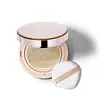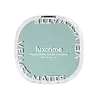Y.O.U Noutriwear+ Flawless Cushion Foundation Versus Luxcrime Perfecting Cover Cushion Velvet Matte SPF 50 PA +++
What's inside
What's inside
 Key Ingredients
Key Ingredients

 Benefits
Benefits

 Concerns
Concerns

No concerns
 Ingredients Side-by-side
Ingredients Side-by-side

Water
Skin ConditioningIsododecane
EmollientCyclopentasiloxane
EmollientGlycerin
HumectantButylene Glycol
HumectantIsononyl Isononanoate
EmollientTitanium Dioxide
Cosmetic ColorantPhenyl Trimethicone
Skin ConditioningDimethicone
EmollientPEG-9 Polydimethylsiloxyethyl Dimethicone
EmulsifyingVinyl Dimethicone/Methicone Silsesquioxane Crosspolymer
Methyl Methacrylate Crosspolymer
Acrylates/Polytrimethylsiloxymethacrylate Copolymer
Skin ConditioningCaprylyl Methicone
Skin ConditioningTridecyl Trimellitate
EmollientBis-PEG/PPG-14/14 Dimethicone
Emollient1,2-Hexanediol
Skin ConditioningMagnesium Sulfate
Bisabolol
MaskingAcrylates/Ethylhexyl Acrylate/Dimethicone Methacrylate Copolymer
Skin ConditioningPhenoxyethanol
PreservativeHydrated Silica
AbrasiveTriethoxycaprylylsilane
Disteardimonium Hectorite
StabilisingAluminum Hydroxide
EmollientHydrogen Dimethicone
Silica Dimethyl Silylate
EmollientAlumina
AbrasiveAroma
Perfluorooctyl Triethoxysilane
Ethylhexylglycerin
Skin ConditioningAloe Barbadensis Leaf Juice
Skin ConditioningCaesalpinia Spinosa Fruit Extract
Skin ProtectingKappaphycus Alvarezii Extract
Skin ConditioningPropanediol
SolventCentella Asiatica Extract
CleansingHelichrysum Stoechas Extract
TonicMoringa Oleifera Seed Extract
Skin ConditioningPentylene Glycol
Skin ConditioningCaprylyl Glycol
EmollientDisodium Phosphate
BufferingCitric Acid
BufferingCI 77891
Cosmetic ColorantCI 77492
Cosmetic ColorantCI 77499
Cosmetic ColorantCI 77491
Cosmetic ColorantWater, Isododecane, Cyclopentasiloxane, Glycerin, Butylene Glycol, Isononyl Isononanoate, Titanium Dioxide, Phenyl Trimethicone, Dimethicone, PEG-9 Polydimethylsiloxyethyl Dimethicone, Vinyl Dimethicone/Methicone Silsesquioxane Crosspolymer, Methyl Methacrylate Crosspolymer, Acrylates/Polytrimethylsiloxymethacrylate Copolymer, Caprylyl Methicone, Tridecyl Trimellitate, Bis-PEG/PPG-14/14 Dimethicone, 1,2-Hexanediol, Magnesium Sulfate, Bisabolol, Acrylates/Ethylhexyl Acrylate/Dimethicone Methacrylate Copolymer, Phenoxyethanol, Hydrated Silica, Triethoxycaprylylsilane, Disteardimonium Hectorite, Aluminum Hydroxide, Hydrogen Dimethicone, Silica Dimethyl Silylate, Alumina, Aroma, Perfluorooctyl Triethoxysilane, Ethylhexylglycerin, Aloe Barbadensis Leaf Juice, Caesalpinia Spinosa Fruit Extract, Kappaphycus Alvarezii Extract, Propanediol, Centella Asiatica Extract, Helichrysum Stoechas Extract, Moringa Oleifera Seed Extract, Pentylene Glycol, Caprylyl Glycol, Disodium Phosphate, Citric Acid, CI 77891, CI 77492, CI 77499, CI 77491
Water
Skin ConditioningCI 77891
Cosmetic ColorantPolymethylsilsesquioxane
Ethylhexyl Methoxycinnamate
UV AbsorberCyclopentasiloxane
EmollientSilica
AbrasiveTrimethylsiloxysilicate
EmollientIsododecane
EmollientEthylhexyl Salicylate
UV AbsorberButylene Glycol
HumectantLauryl PEG-10 Tris(Trimethylsiloxy)Silylethyl Dimethicone
EmulsifyingNiacinamide
SmoothingButylene Glycol Dicaprylate/Dicaprate
EmollientPhenyl Trimethicone
Skin ConditioningPentylene Glycol
Skin ConditioningHdi/Trimethylol Hexyllactone Crosspolymer
Disteardimonium Hectorite
StabilisingC12-15 Alkyl Benzoate
AntimicrobialPEG-9 Polydimethylsiloxyethyl Dimethicone
EmulsifyingPEG-10 Dimethicone
Skin ConditioningMagnesium Sulfate
Phenoxyethanol
PreservativeTriethoxycaprylylsilane
Polypropylsilsesquioxane
Copernicia Cerifera Wax
Octyldodecanol
EmollientPolymethyl Methacrylate
Stearic Acid
CleansingAlumina
AbrasiveEthylhexylglycerin
Skin ConditioningPropylene Carbonate
SolventCeteareth-20
CleansingPolyglyceryl-4 Isostearate
EmulsifyingSteareth-100
Gel FormingDisodium EDTA
Isopropyl Titanium Triisostearate
EmollientCaprylyl Glycol
EmollientHexylene Glycol
EmulsifyingBHT
AntioxidantTocopherol
AntioxidantCaffeine
Skin ConditioningHydrogenated Lecithin
EmulsifyingCetearyl Alcohol
EmollientCeramide NP
Skin ConditioningCeramide Ns
Skin ConditioningCholesterol
EmollientPhytosphingosine
Skin ConditioningCeramide AP
Skin ConditioningCeramide As
Skin ConditioningCeramide EOP
Skin ConditioningWater, CI 77891, Polymethylsilsesquioxane, Ethylhexyl Methoxycinnamate, Cyclopentasiloxane, Silica, Trimethylsiloxysilicate, Isododecane, Ethylhexyl Salicylate, Butylene Glycol, Lauryl PEG-10 Tris(Trimethylsiloxy)Silylethyl Dimethicone, Niacinamide, Butylene Glycol Dicaprylate/Dicaprate, Phenyl Trimethicone, Pentylene Glycol, Hdi/Trimethylol Hexyllactone Crosspolymer, Disteardimonium Hectorite, C12-15 Alkyl Benzoate, PEG-9 Polydimethylsiloxyethyl Dimethicone, PEG-10 Dimethicone, Magnesium Sulfate, Phenoxyethanol, Triethoxycaprylylsilane, Polypropylsilsesquioxane, Copernicia Cerifera Wax, Octyldodecanol, Polymethyl Methacrylate, Stearic Acid, Alumina, Ethylhexylglycerin, Propylene Carbonate, Ceteareth-20, Polyglyceryl-4 Isostearate, Steareth-100, Disodium EDTA, Isopropyl Titanium Triisostearate, Caprylyl Glycol, Hexylene Glycol, BHT, Tocopherol, Caffeine, Hydrogenated Lecithin, Cetearyl Alcohol, Ceramide NP, Ceramide Ns, Cholesterol, Phytosphingosine, Ceramide AP, Ceramide As, Ceramide EOP
Ingredients Explained
These ingredients are found in both products.
Ingredients higher up in an ingredient list are typically present in a larger amount.
Alumina is another name for the compound aluminum oxide. It is used as a thickener, absorbent, and abrasive.
As an absorbent, alumina can give a mattifying effect. It is used in mineral sunscreens to help coat nano-sized filters, such as titanium dioxide. By increasing the size of the UV filters, these ingredients stay on the skin for a longer time. By coating small sized ingredients, alumina helps thicken a product.
Alumina may be used as an abrasive, or exfoliant.
Alumina is naturally occurring in the mineral corundum. Certain varieties of corundum create rubies and sapphires. Corundum is also the crystalline form of alumina.
Learn more about AluminaButylene Glycol (or BG) is used within cosmetic products for a few different reasons:
Overall, Butylene Glycol is a safe and well-rounded ingredient that works well with other ingredients.
Though this ingredient works well with most skin types, some people with sensitive skin may experience a reaction such as allergic rashes, closed comedones, or itchiness.
Learn more about Butylene GlycolCaprylyl Glycol is a humectant and emollient, meaning it attracts and preserves moisture.
It is a common ingredient in many products, especially those designed to hydrate skin. The primary benefits are retaining moisture, skin softening, and promoting a healthy skin barrier.
Though Caprylyl Glycol is an alcohol derived from fatty acids, it is not the kind that can dry out skin.
This ingredient is also used as a preservative to extend the life of products. It has slight antimicrobial properties.
Learn more about Caprylyl GlycolCi 77891 is a white pigment from Titanium dioxide. It is naturally found in minerals such as rutile and ilmenite.
It's main function is to add a white color to cosmetics. It can also be mixed with other colors to create different shades.
Ci 77891 is commonly found in sunscreens due to its ability to block UV rays.
Learn more about CI 77891Cyclopentasiloxane, or D5, is a silicone used to improve texture of products and trap moisture.
D5 is considered lightweight and volatile. Volatile means it evaporates quickly after application. Once evaporated, D5 leaves a thin barrier that helps keep skin hydrated.
It is also an emollient. Emollients help soften the skin and prevent water loss. Silicones create a silky texture in products. D5 helps other ingredients become more spreadable.
Studies show D5 is safe to use in skincare products. We recommend speaking with a skincare professional if you have concerns.
Learn more about CyclopentasiloxaneDisteardimonium Hectorite comes from the clay mineral named hectorite. It is used to add thickness to a product.
It can also help stabilize a product by helping to disperse other ingredients.
Hectorite is a rare, white clay mineral.
Learn more about Disteardimonium HectoriteEthylhexylglycerin (we can't pronounce this either) is commonly used as a preservative and skin softener. It is derived from glyceryl.
You might see Ethylhexylglycerin often paired with other preservatives such as phenoxyethanol. Ethylhexylglycerin has been found to increase the effectiveness of these other preservatives.
Isododecane is a fragrance, emollient, and solvent.
As an emollient, it helps your skin stay soft and hydrated. Emollients help trap moisture into your skin.
Isododecane's role as a solvent makes it a great texture enhancer. It spreads smoothly on skin and does not leave a sticky feeling behind. Isododecane also helps prevent color transfer in makeup products.
Isododecane is not absorbed into skin.
Learn more about IsododecaneMagnesium Sulfate is a salt. More specifically, it is an epsom salt, or the bath salt used to help relieve muscle aches.
Despite having ‘sulfate’ in the name, it isn’t a surfactant or cleansing agent like sodium lauryl sulfate. Unlike those sulfates, magnesium sulfate doesn’t have the same cleansing or foaming properties (it's simply a type of salt).
In cosmetics, Magnesium Sulfate is used to thicken a product or help dilute other solids. It is a non-reactive and non-irritating ingredient.
One study shows magnesium deficiency may lead to inflammation of the skin. Applying magnesium topically may help reduce inflammation.
You can find this ingredient in sea water or mineral deposits.
Learn more about Magnesium SulfatePEG-9 Polydimethylsiloxyethyl Dimethicone is a type of silicone.
Pentylene glycol is typically used within a product to thicken it. It also adds a smooth, soft, and moisturizing feel to the product. It is naturally found in plants such as sugar beets.
The hydrophilic trait of Pentylene Glycol makes it a humectant. As a humectant, Pentylene Glycol helps draw moisture from the air to your skin. This can help keep your skin hydrated.
This property also makes Pentylene Glycol a great texture enhancer. It can also help thicken or stabilize a product.
Pentylene Glycol also acts as a mild preservative and helps to keep a product microbe-free.
Some people may experience mild eye and skin irritation from Pentylene Glycol. We always recommend speaking with a professional about using this ingredient in your routine.
Pentylene Glycol has a low molecular weight and is part of the 1,2-glycol family.
Learn more about Pentylene GlycolPhenoxyethanol is a preservative that has germicide, antimicrobial, and aromatic properties. Studies show that phenoxyethanol can prevent microbial growth. By itself, it has a scent that is similar to that of a rose.
It's often used in formulations along with Caprylyl Glycol to preserve the shelf life of products.
Phenyl Trimethicone is a silicon-based polymer. It is derived from silica.
Phenyl Trimethicone is used as an emollient and prevents products from foaming.
As an emollient, it helps trap moisture in the skin. It is considered an occlusive.
Learn more about Phenyl TrimethiconeTriethoxycaprylylsilane is a silicone used to bind and stabilize ingredients.
As an emulsifier, it helps prevent ingredients from separating. This can help elongate the shelf life of products.
Triethoxycaprylylsilane is often used to coat mineral sunscreens ingredients to help give a better feel. It also helps reduce oxidative stress in sunscreens.
Learn more about TriethoxycaprylylsilaneWater. It's the most common cosmetic ingredient of all. You'll usually see it at the top of ingredient lists, meaning that it makes up the largest part of the product.
So why is it so popular? Water most often acts as a solvent - this means that it helps dissolve other ingredients into the formulation.
You'll also recognize water as that liquid we all need to stay alive. If you see this, drink a glass of water. Stay hydrated!
Learn more about Water